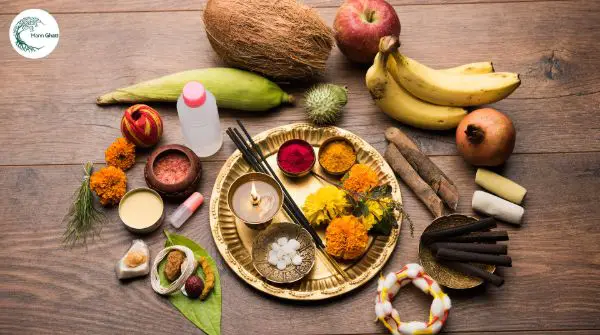Many of us take time out of busy schedules and connect with the divine every day in various ways. We do pooja, meditation, and recharge our home and ourselves for the day. We try to follow the ancient wisdom and traditions laid out by our ancestors and rishis to improve our life. In this process, we use various products, and unknowingly, we end up using the toxic or incorrect products due to the massive industrialization of modern times.
When these toxic products are used, they might not give the intended benefit as promised by the scriptures. They don’t serve the purpose at all, and our efforts only yield partial benefit. So it’s important to replace these products with the right products. Let us understand what those toxic or incorrect products are and see how we can replace them with the right products.
10 toxic or incorrect products unknowingly used in rituals:
1. Incense sticks – These are burnt to remove any negative energies from the place like anger, tension, stress, etc., and to invite angels or devas into a place. Most of the incense sticks available in the market come with heavy chemicals and perfumes which are not environment friendly. When we burn such incense sticks, they cause pollution in the place where they are burnt and don’t clean the place as they are intended to do. The purpose of burning them is lost. So, replace these chemical-loaded incense sticks with natural and eco-friendly variants.
2. Ghee – In many rituals, ghee is used. Many people unknowingly use buffalo ghee. There is a subtle and important difference in the quality of buffalo ghee and cow ghee. Buffalo ghee is rajasic, and cow ghee is satvik. Cow ghee carries golden energies, which are highly auspicious, and buffalo ghee does not have this quality. So, whenever ghee needs to be used in rituals, use cow ghee to gain maximum benefits. Using buffalo ghee does not serve the purpose.
3. Oils – For lighting a diya, oil is used. When a diya is lit, the oil is diffused around the home, along with the spiritual vibrations infused through prayers and chantings. Oils carry the medicinal properties of the seeds from which it is extracted. For example, sesame oil carries the properties of sesame seeds. However, many oils available in the market are refined oils that carry toxic chemicals. So when these refined oils are used for lighting diya, toxic chemicals are diffused around the home, which defeats the purpose of lighting a diya. So, replace these refined oils with cold-pressed oils or cow ghee for gaining the benefits of lighting a diya.
4. Sandalwood – Sandalwood is offered to the Lord as part of the pooja ritual and applied on the forehead. Sandalwood carries the properties of calming the mind and increasing one’s spiritual and mental power. In markets, sandalwood powder is available, which is perfumed and nowhere close to sandalwood. Many people use this in pooja. This does not give any benefits when applied on the forehead because it is artificial and lacks the original properties of sandalwood. So, to gain the benefits, use a sandalwood stick. Rub this stick against a base and extract the sandalwood. Offer such freshly extracted sandalwood to the Lord and apply on the forehead. This brings great benefits. It might take a few minutes of time to extract the sandalwood, but it’s worth it because of the benefits it brings.
5. Milk – Milk is part of many rituals. Many people unknowingly use buffalo milk. There is a huge variation between buffalo milk and cow milk. Buffalo milk lacks the sattvic quality and golden energies present in cow milk. So, replace buffalo milk with cow milk in all rituals. Cow milk brings true value and benefits.
6. Camphor – Camphor is an integral part of all rituals. Camphor available in the market comes with toxic chemicals. Burning such camphor pollutes the place. When the right quality of camphor is used in rituals, it cleanses the space and purifies the mind of the person doing the ritual. So, use an eco-friendly variant of camphor.
7. Jaggery – This is also widely used in rituals. Commercial off-the-shelf jaggery comes with many toxic chemicals. Use organic jaggery, which is free from these toxic chemicals.
8. Honey – Honey is one of the five items that constitute panchamrit. Panchamrit is offered to the Lord and consumed by devotees. Many of the honey variants available in the market are highly heated, and most of the nutrients are lost. For maximum benefit, use raw organic honey. Raw honey retains many nutrients and is medicinal. It adds value and brings the benefits as intended by the scriptures.
9. Plastic containers – Plastic containers carry a lot of toxic chemicals. Avoid using these containers during rituals and pooja. Use stainless steel or copper or silver variants.
10. Loban/Sambrani – When chemical-free sambrani is used, it cleanses the entire space and refreshes the body, mind, and spirit of a person. It also cleanses the place and fills it with positive energies. However, many variants of sambrani available in the market are not eco-friendly and hence don’t give the intended benefit. Replace these variants with eco-friendly variants.
These are some commonly used toxic or incorrect products in rituals and poojas. As much as possible, use the right products. Yes, these right products will be costlier when compared to the toxic products, but it’s worth it because only such products can give the true intended benefit and not the products filled with toxic chemicals or wrong products. When we want maximum benefit for the time we are investing in rituals and pooja,we need to use the right kind of products. Only then the true benefits, as promised by the scriptures, can be achieved.
Go for purity!
Wishing you and your family peace and joy!






